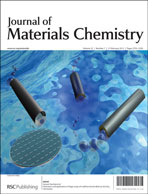Three new isomeric cyclohexylidene linked triphenylamines containing methoxy groups in different positions were synthesized via Ullmann coupling from 1,1-bis(4-aminophenyl)cyclohexane and respective aryl iodides. Thermal behaviour, optical and photoelectrical properties of the obtained materials were investigated. Calculations based on the density functional methods (DFT) were also carried out in order to better understand structure–property relationships. Methoxy-substituted derivatives of 1,1-bis(4-aminophenyl)cyclohexane show lower ionization potentials and higher hole drift mobilities than the corresponding derivative having no methoxy groups. The ionization potentials of the solid samples of the methoxy-substituted compounds established by the electron photoemission technique are in the range of 5.34–5.55 eV. Hole-drift mobility values of the amorphous layers of the methoxy-substituted materials established by the time-of-flight technique range from 4.0 × 10−4 to 1.2 × 10−3 cm2 V−1 s−1 at the electric field of 106 V cm−1. The highest hole mobilities were observed for the para-substituted derivative. Theoretical results suggest that the hole mobility in the bulk materials is driven by the electronic coupling parameter whilst the reorganization energy parameter predicts the wrong mobility trend. The role of the methoxy groups is found to be related to the well-known mesomeric (π-donor) effect and the possibility to establish C–H⋯π(Ph) and C–H⋯X (X = O, N) hydrogen bonds. The effect of these properties on the enhanced Stokes shifts of the para-methoxy-substituted compound, on the decrease of the ionization potentials for the methoxy substituted compounds as compared to the non-substituted one, and on the enhanced possibility to establish considerable electronic couplings between adjacent molecules is discussed in detail.

You have access to this article
 Please wait while we load your content...
Something went wrong. Try again?
Please wait while we load your content...
Something went wrong. Try again?


 Please wait while we load your content...
Please wait while we load your content...